warning TOYOTA CAMRY HYBRID 2014 XV50 / 9.G Repair Manual
[x] Cancel search | Manufacturer: TOYOTA, Model Year: 2014, Model line: CAMRY HYBRID, Model: TOYOTA CAMRY HYBRID 2014 XV50 / 9.GPages: 612, PDF Size: 7.26 MB
Page 512 of 612
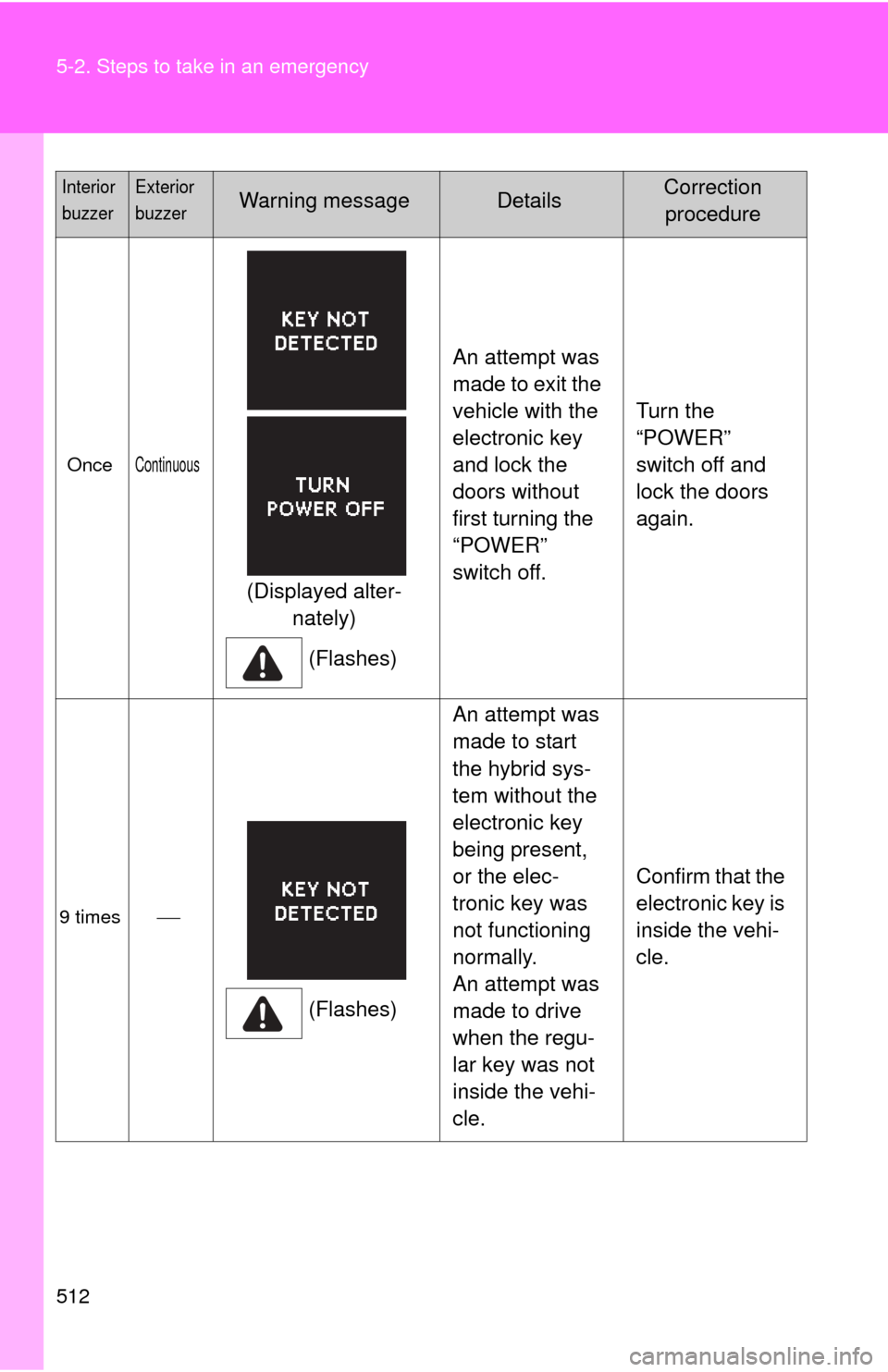
512 5-2. Steps to take in an emergency
OnceContinuous
(Displayed alter-nately)
(Flashes) An attempt was
made to exit the
vehicle with the
electronic key
and lock the
doors without
first turning the
“POWER”
switch off.
Turn the
“POWER”
switch off and
lock the doors
again.
9 times
(Flashes)An attempt was
made to start
the hybrid sys-
tem without the
electronic key
being present,
or the elec-
tronic key was
not functioning
normally.
An attempt was
made to drive
when the regu-
lar key was not
inside the vehi-
cle.
Confirm that the
electronic key is
inside the vehi-
cle.
Interior
buzzerExterior
buzzerWarning messageDetailsCorrection
procedure
Page 513 of 612
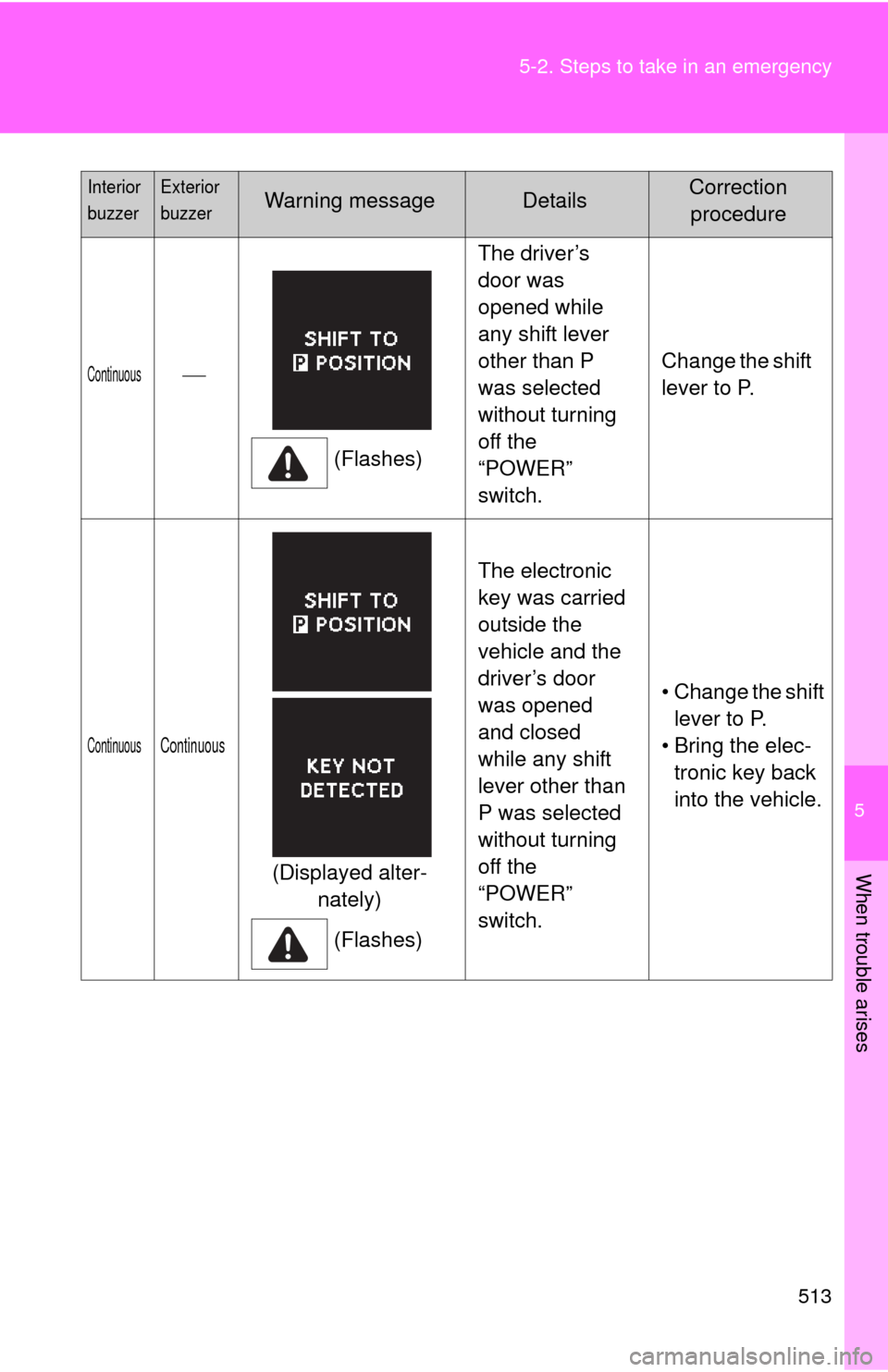
5
When trouble arises
513
5-2. Steps to take in an emergency
Continuous
(Flashes)The driver’s
door was
opened while
any shift lever
other than P
was selected
without turning
off the
“POWER”
switch.
Change the shift
lever to P.
ContinuousContinuous
(Displayed alter-
nately)
(Flashes) The electronic
key was carried
outside the
vehicle and the
driver’s door
was opened
and closed
while any shift
lever other than
P was selected
without turning
off the
“POWER”
switch.
• Change the shift
lever to P.
• Bring the elec- tronic key back
into the vehicle.
Interior
buzzerExterior
buzzerWarning messageDetailsCorrection procedure
Page 514 of 612

514 5-2. Steps to take in an emergency
OnceContinuous
(Flashes)An attempt was
made to lock
the doors using
the smart key
system while
the electronic
key was still
inside the vehi-
cle.
Retrieve the
electronic key
from the vehi-
cle and lock the
doors again.
OnceContinuous
(Flashes)An attempt was
made to lock
either front door
by opening a
door and putting
the inside lock
button into the
lock position,
then closing the
door by pulling
on the outside
door handle
with the elec-
tronic key still
inside the vehi-
cle.
Retrieve the
electronic key
from the vehi-
cle and lock the
doors again.
Interior
buzzerExterior
buzzerWarning messageDetailsCorrection
procedure
Page 515 of 612
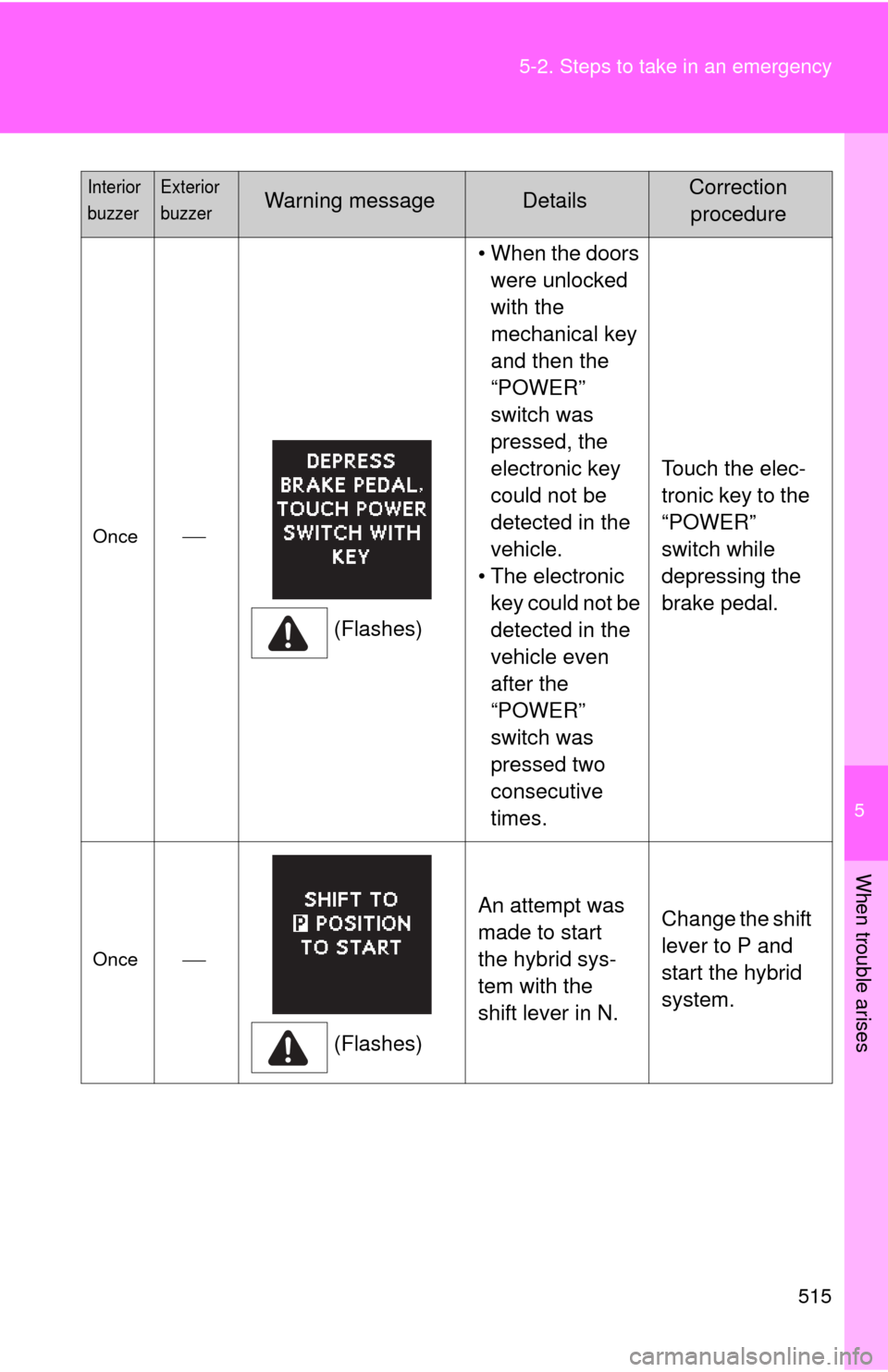
5
When trouble arises
515
5-2. Steps to take in an emergency
Once
(Flashes)• When the doors
were unlocked
with the
mechanical key
and then the
“POWER”
switch was
pressed, the
electronic key
could not be
detected in the
vehicle.
• The electronic key could not be
detected in the
vehicle even
after the
“POWER”
switch was
pressed two
consecutive
times. Touch the elec-
tronic key to the
“POWER”
switch while
depressing the
brake pedal.
Once
(Flashes)An attempt was
made to start
the hybrid sys-
tem with the
shift lever in N.
Change the shift
lever to P and
start the hybrid
system.
Interior
buzzerExterior
buzzerWarning messageDetailsCorrection
procedure
Page 516 of 612
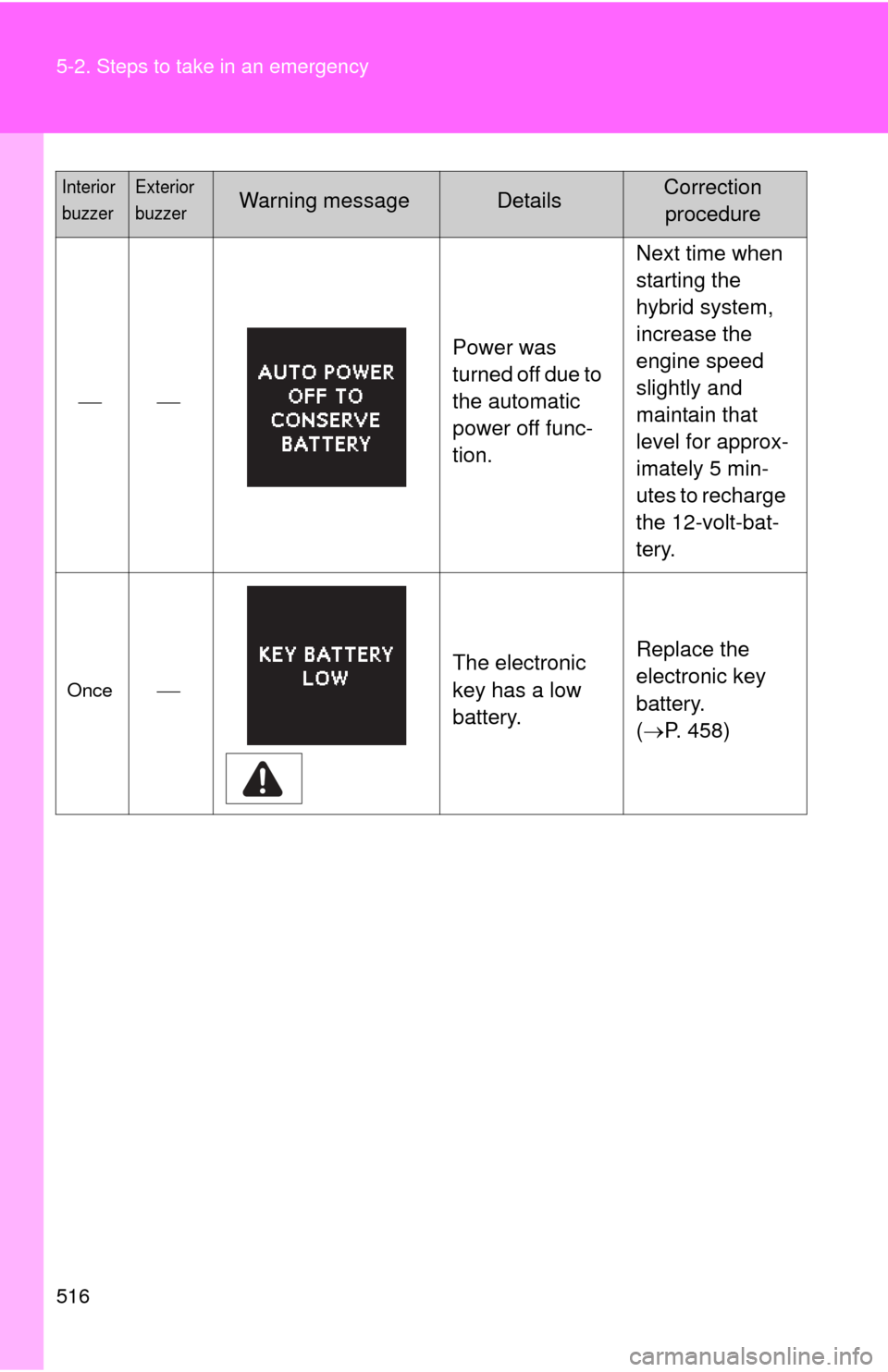
516 5-2. Steps to take in an emergency
Power was
turned off due to
the automatic
power off func-
tion.Next time when
starting the
hybrid system,
increase the
engine speed
slightly and
maintain that
level for approx-
imately 5 min-
utes to recharge
the 12-volt-bat-
tery.
Once
The electronic
key has a low
battery.Replace the
electronic key
battery.
(
P. 458)
Interior
buzzerExterior
buzzerWarning messageDetailsCorrection
procedure
Page 517 of 612
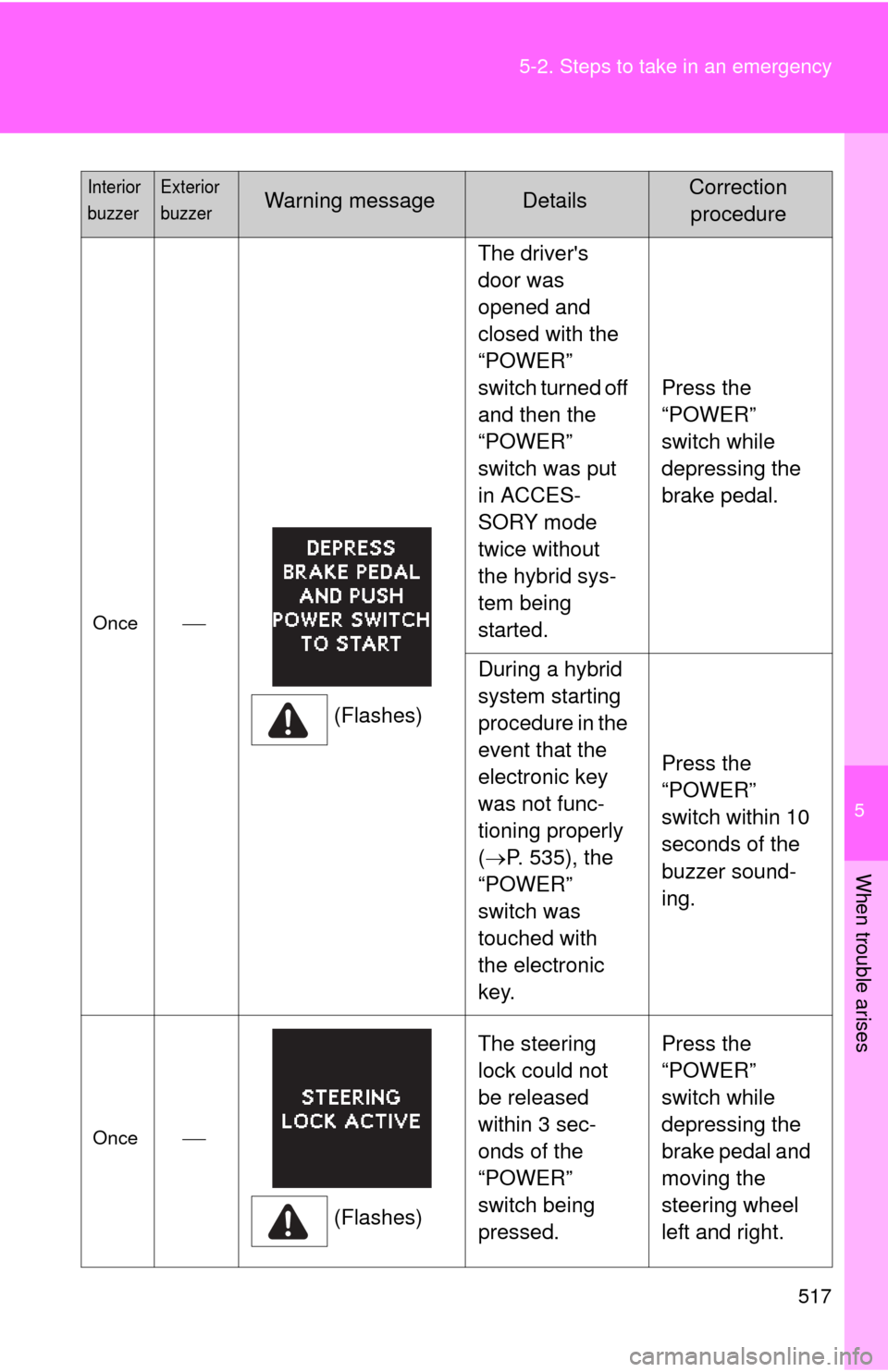
5
When trouble arises
517
5-2. Steps to take in an emergency
Once
(Flashes)The driver's
door was
opened and
closed with the
“POWER”
switch turned off
and then the
“POWER”
switch was put
in ACCES-
SORY mode
twice without
the hybrid sys-
tem being
started.
Press the
“POWER”
switch while
depressing the
brake pedal.
During a hybrid
system starting
procedure in the
event that the
electronic key
was not func-
tioning properly
( P. 535), the
“POWER”
switch was
touched with
the electronic
key. Press the
“POWER”
switch within 10
seconds of the
buzzer sound-
ing.
Once
(Flashes)The steering
lock could not
be released
within 3 sec-
onds of the
“POWER”
switch being
pressed. Press the
“POWER”
switch while
depressing the
brake pedal and
moving the
steering wheel
left and right.
Interior
buzzerExterior
buzzerWarning messageDetailsCorrection
procedure
Page 518 of 612
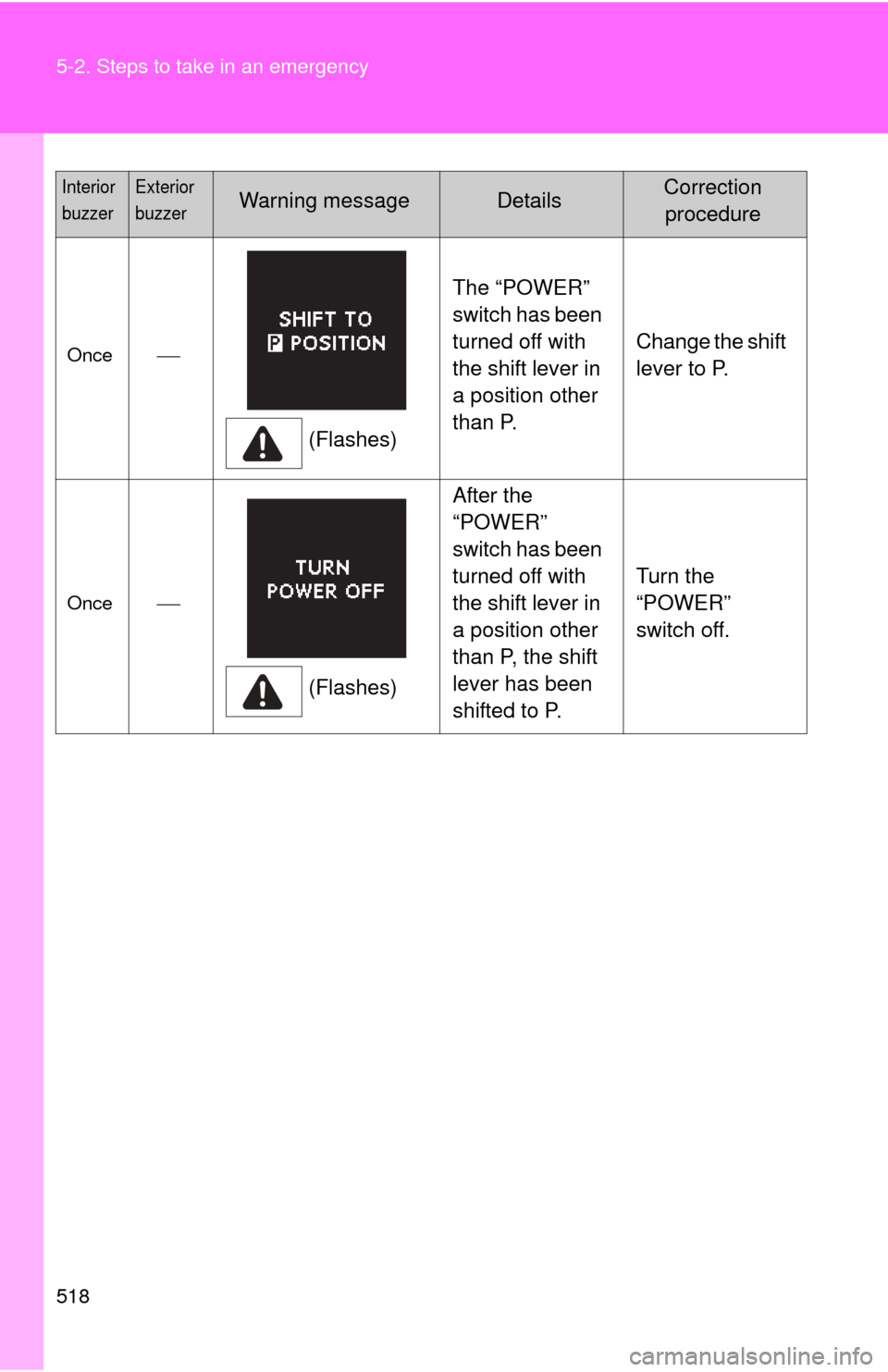
518 5-2. Steps to take in an emergency
Once(Flashes)The “POWER”
switch has been
turned off with
the shift lever in
a position other
than P.
Change the shift
lever to P.
Once
(Flashes)After the
“POWER”
switch has been
turned off with
the shift lever in
a position other
than P, the shift
lever has been
shifted to P.
Turn the
“POWER”
switch off.
Interior
buzzerExterior
buzzerWarning messageDetailsCorrection
procedure
Page 526 of 612

526 5-2. Steps to take in an emergency
■The compact spare tire
●The compact spare tire is identified by the label “TEMPORARY USE
ONLY” on the tire sidewall.
Use the compact spare tire temporarily, and only in an emergency.
●Make sure to check the tire inflation pressu re of the compact spare
tire. ( P. 558)
■When using the compact spare tire
As the compact spare tire is not equipped with a tire pressure warning
valve and transmitter, low inflation pressure of the spare tire will not be
indicated by the tire pressure warn ing system. Also, if you replace the
compact spare tire after the tire pressure warning light comes on, the
light remains on.
■If you have a flat front tire on a road covered with snow or ice
Install the compact spare tire on one of the rear wheels of the vehicle.
Perform the following steps and fit tire chains to the front tires:
Replace a rear tire with the compact spare tire.
Replace the flat front tire with the tire removed from the rear of
the vehicle.
Fit tire chains to the front tires.
STEP1
STEP2
STEP3
Page 530 of 612

530 5-2. Steps to take in an emergency
NOTICE
■Do not drive the vehicle with a flat tire.
Do not continue driving with a flat tire.
Driving even a short distance with a flat tire can damage the tire and the
wheel beyond repair.
■Be careful when driving over bumps with the compact spare tire
installed on the vehicle.
The vehicle becomes lower when driving with the compact spare tire
compared to when driving with standard tires. Be careful when driving
over uneven road surfaces.
■Driving with tire chains and the compact spare tire
Do not fit tire chains to the compact spare tire.
Tire chains may damage the vehicle body and adversely affect driving
performance.
■When replacing the tires (vehicles with a tire pressure warning sys-
tem)
When removing or fitting the wheels, tires or the tire pressure warning
valve and transmitter, contact your Toyota dealer as the tire pressure
warning valve and transmitter may be damaged if not handled correctly.
■To avoid damage to the tire pressure warning valves and transmit-
ters (vehicles with a tire pressure warning system)
When a tire is repaired with liquid se alants, the tire pressure warning
valve and transmitter may not operate properly. If a liquid sealant is
used, contact your Toyota dealer or other qualified service shop as soon
as possible. Make sure to replace the tire pressure warning valve and
transmitter when replacing the tire. ( P. 444)
Page 569 of 612

569
6-1. Specifications
6
Vehicle specifications
■
Treadwear
The treadwear grade is a comparative rating based on the wear
rate of the tire when tested under controlled conditions on a speci-
fied government test course.
For example, a tire graded 150 would wear one and a half (1 - 1/2)
times as well on the government course as a tire graded 100.
The relative performance of tires depends upon the actual conditions
of their use. Performance may diff er significantly from the norm due
to variations in driving habits, service practices and differences in
road characteristics and climate.
■ Traction AA, A, B, C
The traction grades, from highest to lowest, are AA, A, B and C,
and they represent the tire's ability to stop on wet pavement as
measured under controlled cond itions on specified government
test surfaces of asphalt and concrete.
A tire marked C may have poor traction performance.
Warning: The traction grade assigned to this tire is based on braking
(straight ahead) traction tests and does not include cornering (turn-
ing) traction.
■ Temperature A, B, C
The temperature grades are A (the highest), B, and C, represent-
ing the tire's resistance to the generation of heat and its ability to
dissipate heat when tested under controlled conditions on a speci-
fied indoor laboratory test wheel.
Sustained high temperature can cause the material of the tire to
degenerate and reduce tire life, and excessive temperature can lead
to sudden tire failure.
Grade C corresponds to a level of performance which all passenger
car tires must meet under the Federal Motor Vehicle Safety Standard
No. 109.
Grades B and A represent higher levels of performance on the labo-
ratory test wheel than the minimum required by law.